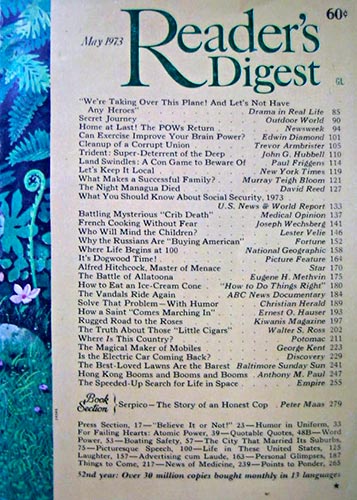 PLEASANTVILLE – So I am reading Peter Canning’s biography of Dewitt and Lila Acheson Wallace, American Dreamers, and seeing how the Wallaces affected so many lives positively, not only with what they accomplished in their philanthropy, but how their philosophy helped shape America at a critical time. I also was stunned at how they died, ignored by those who were supposed to protect them at their estate, High Winds.
PLEASANTVILLE – So I am reading Peter Canning’s biography of Dewitt and Lila Acheson Wallace, American Dreamers, and seeing how the Wallaces affected so many lives positively, not only with what they accomplished in their philanthropy, but how their philosophy helped shape America at a critical time. I also was stunned at how they died, ignored by those who were supposed to protect them at their estate, High Winds.
At its height, it was a book of practical inspiration for living, aggregated very much like today’s web. While not all things were positive (Wallace went on a campaign to reduce car accidents by sharing bloody stories, for instance), he always told the stories with optimism. And he was all about finding solutions, in a uniquely American way.
That was the brand.
Who are the the successors to the Wallaces, and how the Reader’s Digest might take in this era? Reader’s Digest was better tuned to the current web era better than any other publication. It was decades beyond its time; picking apart its parts would help the magazine figure out what its brand is all about today.
Was The Digest the world’s first web “2.0” magazine? You bet. Here’s why:
- The original Huffington Post. Dewitt Wallace liked to condense articles. He loved to cull quotes, to take the most essential elements of a story and put them out there for everyone to read, without the fluff. If there were blogs when he was around, he would have been saving links to stories from across the web and posting, saving the most important points. He would have loved Twitter; he could have saved links to all his favorite stuff. In fact, what Wallace did was like Like Huffington Post, but he actually paid the publication and writer to condense the story, rather than piggybacking on others’ work.

- The original inspiration. Certainly, the Wallaces did not invent the inspiring magazine story. But they made an art form out of it, and the happy little stories remind me of the inspiring stories in email that get forwarded around.
- The original user content. The magazine was packed with bits of packaged information contributed by actual readers themselves, or found in other places. Segments like Life in these United States, Humor in Uniform, All in a Day’s Work, Points to Ponder and It Pays to Enrich Your Word Power. Of course of the segments in the Digest that took user content, they paid well for it, unlike the web.
- The original marketing channel and platform. Reader’s Digest got you hooked. When you got a subscription, you could order books, records, reference guides, whatever. The Reader’s Digest Association got you into their database, and then packed you full of things to read. Again and again. While the basis of the whole platform was the magazine, the magazine was what got you hooked into the rest of the enterprise. Today, that seems even more apt a comparison, as the handy magazine is the entryway to the Digest portal.
- The original global village. Way before other publications figured it out, Reader’s Digest brought an international approach to what they did; they made the assumption that while countries were different, people were very much the same, and need inspiring, entertaining and informative information.
- The outsider: Lila and Dewitt Wallace became the establishment, but they did not follow a route to power through the establishment. They did it completely on their own, and never had to cow-tow to anyone. They started their magazine in a small apartment in Greenwich Village, and moved it to a barn in Pleasantville. At one time, writes Canning, the all-American Digest even sued and went against the CIA.
- The original indexer and search engine. What Reader’s Digest gave Americans was a sense of order. You got the sense by reading The Digest that yes, America and its newspapers and magazines are voluminous, but we at the Digest are poring through all of that, and will show you what is best from all the magazines. In the heyday of print, there was lots of good stuff out there, and Reader’s Digest helped you through it, not only by aggregating the best, but then by segregating it into unique channels.
The magazine may have had its print run trimmed, and it is no longer the giant it was. But it still sells 8 million copies a month, and is the largest in America. And that’s pretty darned powerful readership and database. As it searches for relevance today, it should not overlook its strength and relevance today.









Happy Holidays
BrandlandUSA’re on vacation in June 2011
Wallace is easy to say
Gratitude
Admiration
I love Wallaces and digest. They are my models.
—-01719257631, Bangladesh.